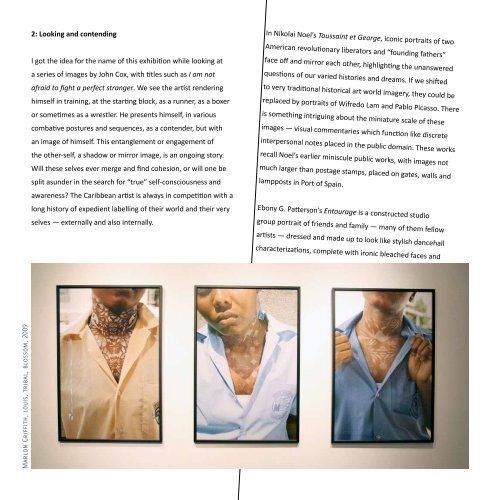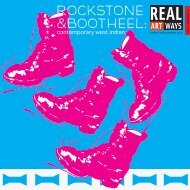Wrestling with the Image: Caribbean Interventions - Blue Curry
Wrestling with the Image: Caribbean Interventions - Blue Curry
Wrestling with the Image: Caribbean Interventions - Blue Curry
Create successful ePaper yourself
Turn your PDF publications into a flip-book with our unique Google optimized e-Paper software.
2: Looking and contending<br />
In Nikolai Noel’s Toussaint et George, iconic portraits of two<br />
American revolutionary liberators and “founding fa<strong>the</strong>rs”<br />
I got <strong>the</strong> idea for <strong>the</strong> name of this exhibition while looking at<br />
face off and mirror each o<strong>the</strong>r, highlighting <strong>the</strong> unanswered<br />
a series of images by John Cox, <strong>with</strong> titles such as I am not<br />
questions of our varied histories and dreams. If we shifted<br />
afraid to fight a perfect stranger. We see <strong>the</strong> artist rendering<br />
to very traditional historical art world imagery, <strong>the</strong>y could be<br />
Marlon Griffith, louis, tribal, blossom, 2009<br />
himself in training, at <strong>the</strong> starting block, as a runner, as a boxer<br />
or sometimes as a wrestler. He presents himself, in various<br />
combative postures and sequences, as a contender, but <strong>with</strong><br />
an image of himself. This entanglement or engagement of<br />
<strong>the</strong> o<strong>the</strong>r-self, a shadow or mirror image, is an ongoing story.<br />
Will <strong>the</strong>se selves ever merge and find cohesion, or will one be<br />
split asunder in <strong>the</strong> search for “true” self-consciousness and<br />
awareness? The <strong>Caribbean</strong> artist is always in competition <strong>with</strong> a<br />
long history of expedient labelling of <strong>the</strong>ir world and <strong>the</strong>ir very<br />
selves — externally and also internally.<br />
replaced by portraits of Wifredo Lam and Pablo Picasso. There<br />
is something intriguing about <strong>the</strong> miniature scale of <strong>the</strong>se<br />
images — visual commentaries which function like discrete<br />
interpersonal notes placed in <strong>the</strong> public domain. These works<br />
recall Noel’s earlier miniscule public works, <strong>with</strong> images not<br />
much larger than postage stamps, placed on gates, walls and<br />
lampposts in Port of Spain.<br />
Ebony G. Patterson’s Entourage is a constructed studio<br />
group portrait of friends and family — many of <strong>the</strong>m fellow<br />
artists — dressed and made up to look like stylish dancehall<br />
characterizations, complete <strong>with</strong> ironic bleached faces and<br />
Abigail Hadeed, Trees <strong>with</strong>out Roots, 1995<br />
androgynous attire. This is real transnational culture, initially<br />
driven by a social underclass, which has become a viral<br />
vernacular reaction to ideas of high and low culture <strong>with</strong>in<br />
<strong>the</strong> class warfare of urban Kingston. The engagement of this<br />
language infers <strong>the</strong> “carnivalesque” — not as folk spectacle coopted<br />
by nationalist regimes, but as social contestation in <strong>the</strong><br />
urban space, satirical and virile.<br />
Marlon James’s Mark and Giselle look back at us from <strong>with</strong>in<br />
<strong>the</strong> frame, but not as generic nameless silhouettes. They are<br />
fellow artists and friends living in Kingston, and co-conspirators<br />
in this declared moment. Their clo<strong>the</strong>s and expression defy<br />
our expectations, along <strong>with</strong> <strong>the</strong> empty background. They<br />
could be young people anywhere — Toronto, Port of Spain,<br />
Johannesburg? Perhaps only a sense of time or <strong>the</strong> “now” is<br />
conveyed when we encounter <strong>the</strong>se images.<br />
In a place like <strong>the</strong> <strong>Caribbean</strong>, we cannot take <strong>the</strong> agency of<br />
portraiture for granted, in <strong>the</strong> aftermath of a much longer<br />
history of topographical and anthropological representations.<br />
The subject position — or <strong>the</strong> role of <strong>the</strong> subject — <strong>with</strong>in <strong>the</strong><br />
frame or field of pictorial representation is highly contested.<br />
Standard regional historical narratives of <strong>the</strong> <strong>Caribbean</strong> recount<br />
or register developmental shifts from persons being privately<br />
owned property — indentured workers and colonial subjects —<br />
to being citizens — of a republic, for example. But in <strong>the</strong> pictorial<br />
domain, we are still anthropological, cultural, national, ethnic<br />
or electoral commodities and signifiers. We remain labelled but<br />
nameless images. The moment of encounter and of exchange<br />
is what is at stake. The question is whe<strong>the</strong>r <strong>the</strong> purpose for<br />
taking <strong>the</strong> image shifts to real portraiture and not simply imagecapture,<br />
in <strong>the</strong> worst sense of <strong>the</strong> term, leaving us as subjected<br />
signs of ourselves, in a kind of cultural dopplegänger-ing that<br />
WRESTLING WITH THE IMAGE CARIBBEAN INTERVENTIONS<br />
9




